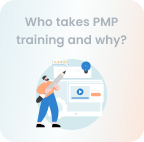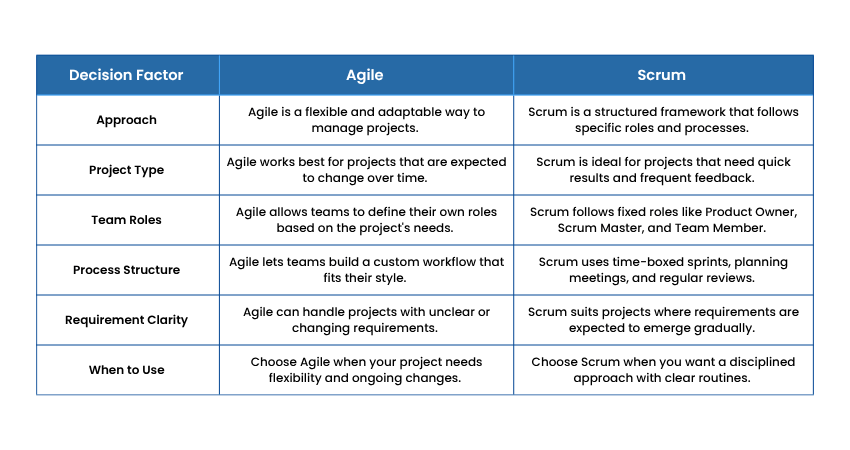







 10 Sep 2024
10 Sep 2024



Is your team Agile, or are you truly following Scrum? In the world of Agile vs Scrum, many teams blur the line between the two without even realizing it. Agile is a mindset focused on flexibility and continuous improvement, while Scrum is a structured framework that applies this mindset through defined roles, events, and time-boxed iterations.
Understanding the Agile vs Scrum distinction is essential choosing the right approach depends on your team’s specific needs and goals. In this blog, we’ll explore what sets them apart, how each approach functions, and help you decide which one can deliver better results for your project environment.
Table of Contents
1) What is an Agile Methodology?
2) What is Scrum Methodology?
3) Agile vs Scrum: Key Difference
4) Agile vs Scrum: Selecting the Best Project Methodology
5) Conclusion
Agile Methodology is a flexible and collaborative approach to manage projects. Agile breaks work into smaller parts called iterations, instead of following a procedural process. After each iteration, teams review their progress and gather feedback. This approach helps teams deliver better results faster and stay aligned with customer needs.
The primary focus of Agile is customer satisfaction because it values communication and coordination in the team. It favours responses to change over heavy planning and long documentations. Teams work closely with key stakeholders to maintain alignment throughout the project. Continuous improvement is a key focus of the Agile process.
a) Agile enables teams to respond rapidly to changing requirements or market conditions
b) Work is divided into small and manageable sprints which results in faster releases
c) Ongoing feedback from customers confirms the product requirements
d) In-house testing on a regular basis during every sprint captures issues early on
e) Agile facilitates open communication, ownership, and teamwork
Agile prioritises working software over complete documentation
a) Constant change and vague requirements can create unmanaged project growth
b) It is very dependent on group decision-making, and it can be a problem for new teams
c) It can be difficult to maintain Agile in large and complicated project
d) There must be constant client contact, which isn't always feasible
Scrum is an Agile framework designed to help teams work together more effectively on complex projects. Its structures work into fixed-length iterations called sprints and it typically lasting 2-4 weeks. At the end of each sprint, teams deliver a potentially shippable product increment.
Scrum emphasises transparency, inspection and adaptation. Teams meet regularly through meetings like daily stand-ups, sprint planning and retrospectives. These helps ensure alignment, accountability and continuous improvement.
Scrum enables fast and frequent delivery through short sprints
a) It encourages strong collaboration and team ownership
b) It allows regular customer feedback for better outcomes
c) It defines clear roles for better accountability
d) It promotes continuous improvement via retrospectives
a) Scrum requires full team commitment and discipline.
b) It is difficult to scale across large or complex teams.
c) The scope of Scrum can expand if backlog isn’t controlled.
d) Teams with lesser or no experience may struggle with self-organization.
e) Frequent meetings in Scrum can become time-consuming
Here’s a clear comparison between Agile and Scrum to help you understand their key differences across important project aspects:

Agile is a flexible and adaptable way to manage projects, focusing on continuous improvement and collaboration. Scrum is a specific Agile framework that follows defined roles, structured processes, and fixed development cycles.
Agile works best for projects that are expected to change over time. It provides the flexibility to adapt quickly as requirements evolve. Scrum is ideal for projects that require quick results and frequent feedback through short, time-boxed development cycles.
In Agile, teams have the freedom to define their own roles based on the project’s needs. Scrum, however, assigns fixed roles with specific responsibilities, including the Product Owner, Scrum Master, and Development Team.
Agile allows teams to build custom workflows that suit their working style and project goals. Scrum follows a more structured process, which includes time-boxed sprints, sprint planning, daily stand-ups, and regular sprint reviews.
Agile is well-suited for projects with unclear or frequently changing requirements, making it ideal for fast-moving or uncertain environments. Scrum is suited for projects where requirements are expected to emerge and evolve gradually, refined through continuous customer feedback and team collaboration.
Choose Agile when your project needs flexibility, fast adaptation, and continuous changes. Scrum is the better choice when you need a disciplined, structured approach with clear routines, defined roles, and predictable development cycles.
Unlock new career opportunities with Scrum Developer Certification Training — Register now!
Choosing between Agile and Scrum depends on your project’s complexity, flexibility needs, and team structure. Agile is a broad project management approach that promotes adaptability, continuous feedback, and collaboration, making it ideal for projects with changing requirements.
Scrum, a specific Agile framework, offers a more structured process with defined roles, time-boxed sprints, and regular reviews, making it perfect for teams needing clear routines and rapid delivery. Understanding your project goals and team dynamics will help you select the best methodology to ensure smooth progress and successful outcomes.
In the Agile vs Scrum debate, the right choice depends on your project’s needs. Agile offers flexibility for changing requirements, while Scrum provides a structured framework with defined roles and sprints. Understanding both approaches helps teams deliver efficiently and choose the best fit for their workflow.
Advance your Agile career today with Scrum Product Owner Certification — Join now!






© Copyright 2025. All rights reserved. Contact: PMP® TRAINING ACADEMY.
